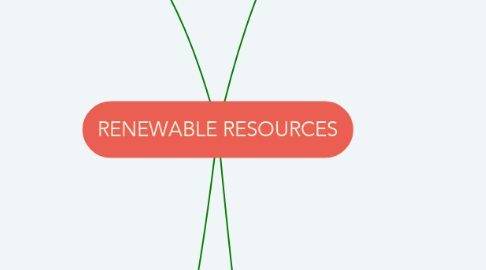
1. HYDROPOWER
1.1. Introduction
1.1.1. Reaction turbines - totally embedded in the fluid and powered from the pressure drop across the device. Impulse turbines - the flow hits the turbine as a jet in an open environment, with the power deriving from the kinetic energy of the flow.
1.2. Principles
1.2.1. Measurement of head H
1.2.2. Measurement of flow rate Q
1.3. An impulse turbine
1.3.1. Jet velocity & nozzle size
1.3.2. Angular velocity & turbine size
1.4. Reaction turbines
1.5. Hydroelectric systems
1.6. Power regulation and control
1.7. System efficiency
1.7.1. The haudralic ram pump
1.7.2. Operation is as follow
1.7.3. Social environmental aspects
2. WIND ENERGY RESOURCES
2.1. Introduction
2.1.1. Wind Power
2.2. Turbine types and terms.
2.2.1. Horizontal-axis machines
2.2.2. Vertical-axis machines
2.2.2.1. 1. Cup anemometer 2. Savonius rotor (turbo machine) 3. Darrieus rotor 4. Musgrove rotor 5. Evans rotor
2.2.3. Concentrators
2.3. Linear momentum and basic theory
2.4. Characteristic of the wind
2.4.1. 1. Wind speed patterns 2. Wind Speed Distribution: The 3.Macrometeorological range 4. Micro-meteorological Range: 5.Turbulence 6. Distribution of Wind Direction 7. Wind Shear Profile 8. Long-term Fluctuations
2.5. Power extraction by a turbine
2.6. Electricity generation
2.6.1. Classification of electricity systems using wind power
2.6.1.1. Class A: wind turbine capacity dominant, PT >> PG 1. Mechanical control of the turbine blade 2. Load control
2.6.1.2. Class B: wind turbine capacity ~ other generator capacity, PT~PG 1. Single mood electricity supply distribution 2. Multiple-mode distribution
2.6.1.3. Class C: grid linked, wind turbine embedded in a large system, PT < 0.2 PG
2.7. Mechanical power
2.7.1. 1. Sea transport 2. Grain milling 3. Water pumping 4. Heat production
3. PRINCIPLE OF RENEWABLE ENERGY
3.1. Energy & sustainable development
3.1.1. Principles & major issues
3.1.2. Numerical model
3.1.2.1. R = EN R - is the total yearly energy requirement for a population of N people. E - is the per capita energy-use averaged over one year, related closely to provision of food and manufactured goods. The unit of E is energy per unit time, i.e. power.
3.1.3. Global resources
3.2. Fundamentals
3.2.1. Definitions
3.2.1.1. Renewable energy - Energy obtained from natural and persistent flows of energy occurring in the immediate environment Non-renewable energy - Energy obtained from static stores of energy that remain underground unless released by human interaction
3.2.2. Energy sources
3.2.2.1. There are five ultimate primary sources of useful energy: 1. The Sun. 2. The motion and gravitational potential of the Sun, Moon and Earth. 3. Geothermal energy from cooling, chemical reactions and radioactive decay in the Earth. 4. Human-induced nuclear reactions. 5. Chemical reactions from mineral sources
3.2.3. Environmental energy
3.2.4. Primary supply to end-use
3.2.5. Energy planning
3.2.5.1. 1. Complete energy systems must be analysed and supply should not be considered separately from end-use. 2. System efficiency calculations can be most revealing and can pinpoint unnecessary losses. 3. Energy management is always important to improve overall efficiency and reduce economic losses.
3.3. Scientific principles of renewable energy
3.3.1. Energy currents
3.3.2. Dynamic characteristics
3.3.3. Quality of supply
3.3.4. Dispersed versus centralised energy
3.3.4.1. 1. Mechanical supplies 2. Heat supplies 3. Photon processes
3.3.5. Complex systems
3.3.6. Situation dependence
3.4. Technical implications
3.4.1. Prospecting environment
3.4.2. End-use requirements & efficiency
3.4.3. Matching supply & demand
3.4.4. Control options
3.4.4.1. 1. spill the excess energy, 2. incorporate storage and 3. operate load management control.
3.5. Social implications
3.5.1. Dispersed living
3.5.2. Pollution & environtmental impact
3.5.3. The future
4. SOLAR ENERGY RESOURCES
4.1. Solar radiation
4.1.1. Components of radiation
4.1.1.1. Gt = Gb + Gd
4.1.2. Atmospheric absorption & related processes
4.1.2.1. Absorption in the atmosphere
4.1.2.2. Scattering
4.1.2.3. Reflection
4.1.3. Measurements of solar radiation
4.2. Solar water heating
4.2.1. Definition
4.2.1.1. active system, solar collecting panels, the storage unit and the energy distribution system are installed with one or more working fluids. passive system all the functions of collection, storage and distribution are carried out by the materials themselves.
4.2.2. Improved solar water heaters
4.2.2.1. 1. Sheltered black container 2. Metal plate collectors with moving fluid 3. Efficiency of a flat plate collector
4.3. Building and other solar thermal applications.
4.3.1. Air heaters
4.3.2. Energy-efficient buildings
4.3.2.1. Solar passive techniques
4.3.2.1.1. 1. Direct gain system 2. Indirect gain system (Thermal storage wall)
4.3.3. Crop driers
4.3.4. Water desalination
4.3.5. Solar ponds
4.3.6. Solar thermal electric power systems
4.3.6.1. 1. Distributed collectors 2. Power tower
4.4. Photovoltaics generation
4.4.1. The P-N junction
4.4.2. PV cell appliacation
4.4.2.1. 1. Utility power generation 2. Space systems 3. Solar powered products

